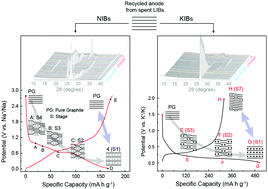当前位置:
X-MOL 学术
›
Energy Environ. Sci.
›
论文详情
Our official English website, www.x-mol.net, welcomes your feedback! (Note: you will need to create a separate account there.)
Staging Na/K-ion de-/intercalation of graphite retrieved from spent Li-ion batteries: in operando X-ray diffraction studies and an advanced anode material for Na/K-ion batteries†
Energy & Environmental Science ( IF 32.5 ) Pub Date : 2019-11-06 , DOI: 10.1039/c9ee02759a Hao-Jie Liang 1, 2, 3, 4, 5 , Bao-Hua Hou 1, 2, 3, 4, 5 , Wen-Hao Li 3, 4, 5, 6, 7 , Qiu-Li Ning 1, 2, 3, 4, 5 , Xu Yang 1, 2, 3, 4, 5 , Zhen-Yi Gu 3, 4, 5, 6, 7 , Xue-Jiao Nie 1, 2, 3, 4, 5 , Guang Wang 1, 2, 3, 4, 5 , Xing-Long Wu 1, 2, 3, 4, 5
Energy & Environmental Science ( IF 32.5 ) Pub Date : 2019-11-06 , DOI: 10.1039/c9ee02759a Hao-Jie Liang 1, 2, 3, 4, 5 , Bao-Hua Hou 1, 2, 3, 4, 5 , Wen-Hao Li 3, 4, 5, 6, 7 , Qiu-Li Ning 1, 2, 3, 4, 5 , Xu Yang 1, 2, 3, 4, 5 , Zhen-Yi Gu 3, 4, 5, 6, 7 , Xue-Jiao Nie 1, 2, 3, 4, 5 , Guang Wang 1, 2, 3, 4, 5 , Xing-Long Wu 1, 2, 3, 4, 5
Affiliation

|
The graphite material from exhausted Li-ion batteries (LIBs) is reused as a favorable anode for Na-ion batteries (NIBs) and K-ion batteries (KIBs) through a recycling treatment. The optimized electrode delivers improved electrochemical performance, such as 162 mA h g−1 in NIBs at 0.2 A g−1 and 320 mA h g−1 in KIBs at 0.05 A g−1. In addition, the insights into Na/K-ion de-/intercalation model evolution and corresponding electrochemical analysis are conducted through in operando X-ray diffraction and a series of other characterization methods, discovering a visible transitional stage for NIBs and an irreversible initial cycle phase transformation for KIBs. In a word, we not only provide a new recycling concept for waste graphite anodes but also carry out a series of significant intercalation mechanism studies, which contribute to anode recycling and shed light on the development of graphite material for promising alternative ion batteries.
中文翻译:

从废锂离子电池回收的石墨的分阶段Na / K离子脱除/插层:在操作X射线衍射研究中和用于Na / K离子电池的高级阳极材料†
废锂离子电池(LIB)产生的石墨材料经过回收处理后,可以作为Na离子电池(NIB)和K离子电池(KIB)的良好阳极再利用。优化的电极提供了改进的电化学性能,如162毫安汞柱-1在0.2 A克钞-1和320毫安汞柱-1 0.05 A G在KIBS -1。此外,通过操作来深入了解Na / K离子去离子/插层模型的演化以及相应的电化学分析。X射线衍射和其他一系列表征方法,发现了NIB的可见过渡阶段和KIB的不可逆初始循环相变。简而言之,我们不仅为废石墨阳极提供了一种新的回收概念,而且还进行了一系列重要的插层机理研究,这些研究有助于阳极回收,并为开发用于有希望的替代离子电池的石墨材料提供了启示。
更新日期:2019-12-04
中文翻译:

从废锂离子电池回收的石墨的分阶段Na / K离子脱除/插层:在操作X射线衍射研究中和用于Na / K离子电池的高级阳极材料†
废锂离子电池(LIB)产生的石墨材料经过回收处理后,可以作为Na离子电池(NIB)和K离子电池(KIB)的良好阳极再利用。优化的电极提供了改进的电化学性能,如162毫安汞柱-1在0.2 A克钞-1和320毫安汞柱-1 0.05 A G在KIBS -1。此外,通过操作来深入了解Na / K离子去离子/插层模型的演化以及相应的电化学分析。X射线衍射和其他一系列表征方法,发现了NIB的可见过渡阶段和KIB的不可逆初始循环相变。简而言之,我们不仅为废石墨阳极提供了一种新的回收概念,而且还进行了一系列重要的插层机理研究,这些研究有助于阳极回收,并为开发用于有希望的替代离子电池的石墨材料提供了启示。


























 京公网安备 11010802027423号
京公网安备 11010802027423号